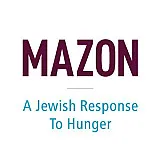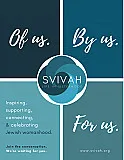How To Use This Haggadah
Running the Seder
Once everyone is seated at the table, it may be helpful to provide a bit of information about Passover and its traditions, as well as set some expectations before launching into the seder. Explain how long you predict the seder will run, when you anticipate dinner to be and if there will be food served before dinner.
It may also be helpful to discuss how you intend to handle participation in the seder. If you plan to go around the table, letting everyone read a paragraph, let your guests know how that will work. There’s not a lot of Hebrew in this Haggadah, but it’s helpful to let your guests know there is some and they can choose to read it if they know Hebrew or just read the English.
Here’s a list of supplies you’ll need to host the seder (keep reading for more detailed descriptions):
On the table:
- Seder plate and symbolic food items
- Plate with three pieces of matzah covered by a cloth or napkin
- Wine or grape juice
- Kiddush cup (any wine glass will do)
- Elijah’s cup (any wine glass will do)
- Small bowls of salt water
- Plate with extra matzah
- Cloth or napkin for wrapping the afikoman
- Prize for finding the afikoman
- Optional items:
- Hard-boiled eggs
- Veggies or other light foods to munch on during the seder
- Interactive props (you can make your seder more engaging with things like toys, for example, to represent the 10 plagues)
At each chair:
- Standard dinner place setting, with appetizer plate
- Wine glass
- Pillow for reclining
Hiding the Afikoman
There are three pieces of matzah stacked on the table covered by a cloth or napkin. When indicated in the Haggadah, you will break the middle matzah into two pieces. The leader and/or host should wrap up the larger half and, at some point before the end of dinner, find a place to hide it. This piece is called the afikoman , literally “dessert” in Greek.
After dinner, the guests will have to hunt for the afikoman to wrap up the meal—and win a prize! Make sure to have a reward handy for the lucky winner; cash works but you can also be as creative as you want. Once the afikoman is found and redeemed, send it around the table so everyone can eat a small piece of it for dessert.
The Four Questions
The Four Questions are traditionally sung by the youngest participant at the seder. These questions are designed to help explain how the evenings of Passover are different from regular evenings. There’s a tune for these questions and often someone will know it. If you and/or your guests aren’t familiar with the Hebrew, just read them in English as you would the rest of the seder.
Serving the Meal
No one should have to skip the seder because they’re stuck in the kitchen preparing the meal. Luckily, many great seder foods, from brisket to roast chicken to kugel to tzimmes, a traditional carrot dish, can be prepared ahead and left in a warm oven.
But you don’t need to wait to feed your guests until the meal portion of the Haggadah. The Karpas – Deeping a green vegetable in salt water section, which happens fairly early, was designed by rabbis as a way to work appetizers into the seder. After you’ve dipped your vegetables into salt water and said the corresponding blessing, consider bringing out a vegetable course, the gefilte fish or the boiled eggs.
Setting the Table
First and foremost, Passover is a holiday, so don’t be shy about using a nice tablecloth and fancy china, or fun paper plates if that suits you best. One of the mainstays of celebrating Passover is not eating anything leavened, called chametz in Hebrew, for the duration of the holiday. This includes the most obvious: bread, cake, cookies and the like, as well as less obvious things, like corn products. As with anything in Judaism, there are many opinions and traditions about what is and is not acceptable to eat on Passover. You can be as strict or as lax as you’d like for your seder, but take the time to think about it when planning your dinner. Just as you would with any other meal you host, ask your guests if they have any dietary needs, and make sure they understand the Passover food rules you’ve decided on for this event. Some people keep their Passover meals extra safe from chametz by using specific plates only for Passover. So if you want to use paper goods instead of china, go ahead, whether in the name of being extra kosher for Passover or not wanting to wash a million dishes.
The Seder Plate
The seder plate holds most of the main symbols we talk about during the seder. There are many beautiful seder plates handed down through generations, and certainly many that are available for purchase with a wide variety of artistry and cost. A seder plate will usually have specific spaces, often named, for each item. Since there can be a bit of variation on what appears on a seder plate, some have five spaces, while others have six. Several things have been added in recent times to the seder plate (listed below) and are optional but certainly meaningful. Although there might not be a designated place for these items on the average seder plate, feel free to add them where they fit or just put them on the table.
Roasted egg ( Beitzah )
The roasted egg (yes, roasted!) symbolizes rebirth and springtime. Just as we grew into a free nation through our exodus from Egypt, the egg symbolizes growth and new life. Boil your egg first, then put it inside the oven (at about 350 degrees) and roast it until the shell starts to brown. (But if you use a simple boiled egg, no one is likely to know the difference.) Looking for a vegan substitute? Try plant seeds, an avocado pit or a large nut.
Bitter herb ( Maror )
Generally, this is horseradish, which embodies the bitterness of slavery. Traditionalists will tell you it must be the actual horseradish root. But many people use the chopped stuff from a jar, which can then do double-duty as a condiment for your gefilte fish. Note: A little horseradish goes on the seder plate, but everyone will eat a bit of bitter herb during the seder. You can either put it on individual plates or in a few little bowls on the table.
Chopped apples and nuts ( Charoset )
This is the fruit-based mixture that represents the mortar of bricks we laid as slaves in Egypt. It’s also sweet, like freedom. Just about every Jewish community in the world has its own take on charoset , so if you’re feeling ambitious, Google different recipes and make a few! Note: Like the horseradish, just a little bit of charoset goes on the seder plate. Put most of it in bowls around the table so everyone can enjoy it during the seder.
Shank bone ( Zeroah )
This is a symbol of the Passover lamb; our forefathers used its blood to mark their doorposts, and the angel of death passed over their homes in the Passover story. Often, you can ask your butcher for a piece of lamb shank bone. In the weeks leading up to Passover, kosher specialty stores will have shank bones available, but they can go fast. Before you put it on the plate, remember to roast it—you wouldn’t want raw animal parts on your table! (You can even throw it in the oven with the egg.) If you miss out or forget to purchase an actual lamb shank bone, you wouldn’t be the first to substitute a chicken leg bone. Want a vegetarian option? Steamed or roasted beets have a deep red color and serve as a popular alternative.
Lettuce ( Chazeret )
This is the one that sometimes gets left off, but the idea here is to use Romaine or a similarly bitter green, which takes on the symbolism of both the bitter herbs and the parsley, of slavery and renewal.
Optional modern additions
- Orange for LGBTQ and gender equality
- Artichoke heart for the inclusion of interfaith families
- Fair-trade chocolate or cocoa beans for economic freedom (most of the world’s chocolate production relies on underpaid or slave laborers, often children)
- Tomato for solidarity with those suffering from slavery, underpaid labor and oppressive working conditions in American agriculture
- Olive for peace in the Middle East
- Cashews for support of American troops
- Banana for standing with refugees
- Pinecone to call out for criminal justice reform
Other Items on the Table
Salt water
Since you need to dip the parsley in salt water, be sure to mix up little bowls of salt water and sprinkle them around the table.
Water for hand-washing
If you’re so inclined, you may want to have a pitcher and bowl on a side table for the ritual washing that takes place. If not, people can get up and wash at the sink. For a contemporary riff on the ritual, pass around moist towelettes or hand sanitizer.
Matzah
For the seder itself, you’ll need three pieces of matzah on a plate, covered by a cloth or napkin. Unlike the items on the seder plate, you will eat this matzah at specific points in the seder. It’s traditional to use only plain matzah here, although some people choose their favorite flavor. Since many people love to munch on matzah, you could have an additional plate of it on the table.
Elijah’s Cup
Toward the end of the seder, it’s traditional to open the door to welcome in the prophet Elijah. If he does, in fact, come through your door, it’s probably a good idea to have some wine waiting for him in an extra glass. Some families have special, fancy wine goblets specifically made to be “Elijah’s Cup,” but any wine glass on the table not assigned to a guest will do. Some leaders fill Elijah’s Cup at the start of the seder; others wait until the part of the seder that specifically mentions Elijah.
Miriam’s Cup
Even though Miriam, the sister of Moses, plays an essential role in the Passover story, the traditional Haggadah text minimizes her by heavily focusing on the male figures. In the modern era and in progressive Judaism, there is great emphasis on egalitarianism and recognizing both our forefathers and foremothers. To celebrate Miriam’s contributions in the Exodus story, many have added a second cup. Miriam’s Cup is filled with water to symbolize Miriam’s well, which often provided much-needed water for the Israelites wandering in the desert after their exodus from Egypt.
Happy hosting!
The Wandering Is Over Haggadah
- Introduction
- Kadesh
- Urchatz
- Karpas
- Yachatz
- Maggid - Beginning
- -- Four Questions
- -- Four Children
- -- Exodus Story
- -- Ten Plagues
- -- Cup #2 & Dayenu
- Rachtzah
- Motzi-Matzah
- Maror
- Koreich
- Shulchan Oreich
- Tzafun
- Bareich
- Hallel
- Nirtzah
- Commentary / Readings
- Songs
Inspired to create
your own Haggadah?
Make your own Haggadah and share with other Seder lovers around the world
Have an idea
for a clip?
People like you bring their creativity to Haggadot.com when they share their ideas in a clip
Support Us
with your donation
Help us build moments of meaning and connection through
home-based Jewish rituals.
OUR TOP CONTRIBUTORS
Passover Guide
Hosting your first Passover Seder? Not sure what food to serve? Curious to
know more about the holiday? Explore our Passover 101 Guide for answers
to all of your questions.






















